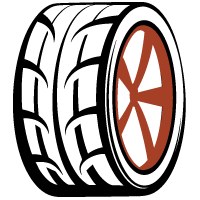2006 닷지 바이퍼 휠 장착 가이드 2006 닷지 바이퍼에 맞는 휠 및 타이어 찾기

2006 닷지 바이퍼 III (ZB I) [2003 .. 2006] - 개조
닷지 바이퍼 III (ZB I) [2003 .. 2006] 8.3i
496 hp- 세대: III (ZB I) [2003 .. 2006] [USDM]
- 제작: [2003 .. 2006]
-
판매 지역: 미국, 유럽, 러시아
-
파워: 496 hp | 370 kW | 503 PS
- 엔진: 8.3 L, , Petrol
- 차체 유형: 로드스터
-
센터 보어 / 허브 보어:
-
볼트 패턴 (PCD): ()
-
휠 고정 장치: 러그 너트
-
스레드 크기:
-
휠 조임 토크:알 수 없음
| 타이어 | 림 | 오프셋 범위 mm | 백스페이스 mm 인치 | 타이어 중량 kg lb |
|
||
|---|---|---|---|---|---|---|---|
|
OE
275/35ZR18
87Z
345/30ZR19 98Z |
10Jx18 ET50.8
13Jx19 ET71.1 |
48.8 - 52.8 69.1 - 73.1 |
190 249 7.48 9.80 |
11.5 14.6 25.4 32.2 |
2.0 29 |
OE
|
|
|
315/30ZR18
85Z
345/30ZR19 98Z |
11Jx18 ET49
13Jx19 ET71.1 |
201 249 7.91 9.80 |
12.4 14.6 27.4 32.2 |
2.0 29 |
|
닷지 바이퍼 III (ZB I) [2003 .. 2006] 8.3i
510 hp- 세대: III (ZB I) [2003 .. 2006] [USDM]
- 제작: [2003 .. 2006]
-
판매 지역: 미국
-
파워: 510 hp | 380 kW | 517 PS
- 엔진: 8.3 L, , Petrol
- 차체 유형: 쿠페
-
센터 보어 / 허브 보어:
-
볼트 패턴 (PCD): ()
-
휠 고정 장치: 러그 너트
-
스레드 크기:
-
휠 조임 토크:알 수 없음
| 타이어 | 림 | 오프셋 범위 mm | 백스페이스 mm 인치 | 타이어 중량 kg lb |
|
||
|---|---|---|---|---|---|---|---|
|
OE
275/35ZR18
87Z
345/30ZR19 98Z |
10Jx18 ET50.8
13Jx19 ET71.1 |
48.8 - 52.8 69.1 - 73.1 |
190 249 7.48 9.80 |
11.5 14.6 25.4 32.2 |
2.0 29 |
OE
|
|
|
315/30ZR18
85Z
345/30ZR19 98Z |
11Jx18 ET49
13Jx19 ET71.1 |
201 249 7.91 9.80 |
12.4 14.6 27.4 32.2 |
2.0 29 |
|
The size of the hole in the center of a wheel is known as the center bore or centerbore.
- Recommended for winter
- Run-flat tires
- Link comes to the calculator page for comparison
- Steel wheels
OE - Original Equipment
![]() - Tire Pressure
- Tire Pressure
![]() - Front axle
- Front axle
![]() - Rear axle
- Rear axle
Offset is the distance in millimetres from the centre line of the wheel to the wheel’s mounting face. Given that the mounting face can be either in front of or behind the centreline, the offset can be either neutral, positive or negative.
Wheel backspace is the distance from a wheel's mounting surface to the back edge of the wheel.
The Pitch Circle Diameter (PCD) is the diameter of the circle which passes through the centre of all the studs, wheel bolts or wheel rim holes
hp - Mechanical horsepower
kW - Kilowatts
PS - Metric horsepower
Tire pressure is a vehicle's recommended cold tire inflation pressure. It is measured in bars or PSI (pounds per square inch).
A sales region is a global automotive region in which a vehicle was officially sold or is still being sold.
Ex.: 7J x 15 Rim width (inches) x rim diameter (inches)
ISO standard Ex.: M12 x 1.25 Nominal diameter (mm) x pitch (mm)
UN-series Ex.: 9/16" - 18 UNF
Thread size (in) - thread pitch
UNF - Unified National Fine Thread
Example: 215/55 R16 91 T
215 is the tire width in mm
55 is the ratio of profile height to width or simply 'profile'. With the same width, the larger this indicator, the higher the tire will be and vice versa
16 - diameter of the wheel (disk) in inches. (It is the diameter, not the radius!). This is the inner size of the tire or the outer size of the rim
91 - load index. This is the level of maximum permissible load on one wheel
T - tire speed index
The method of attaching a wheel to a hub: wheel nuts or wheel bolts
The torque value specified by the manufacturer for wheel bolts or wheel nuts, which is to be set when tightening on the torque tool (torque setting). A rotational force given in Newton metres (Nm) or foot-pounds (ft-lbs), wheel torque measures lug nut / bolts tightness
The tires included with a new vehicle when it is purchased. OE tires are specifically chosen by the vehicle manufacturer to make the most of the vehicle's performance characteristics.

![닷지 바이퍼 III (ZB I) [2003 .. 2006] [USDM] 닷지 바이퍼 III (ZB I) 쿠페](https://cdn.wheel-size.com/thumbs/4c/43/4c43d93d0ddb48e2642e5d9ff11f9f69.jpg)
![닷지 바이퍼 III (ZB I) [2003 .. 2006] [USDM] 닷지 바이퍼 III (ZB I) Convertible](https://cdn.wheel-size.com/thumbs/2a/4c/2a4c708211441f54983f31c17b712846.jpg)




